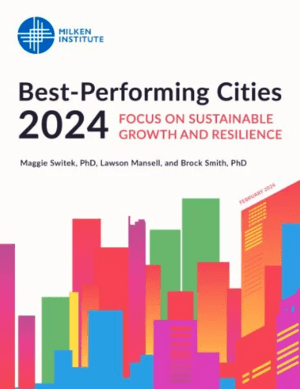

 After a remarkable three-year run as the top-ranked large metropolitan area in the Milken Institute’s 2024 Best-Performing Cities Index, Provo–Orem shifts from the top spot to number five, in large metro areas. “That kind of fall is to be expected as city growth becomes more stable and slows down.” explained the main author of the report, Maggie Switek, PhD, Senior Director of the Milken Institute’s Research Department, in a conversation with TechBuzz.
After a remarkable three-year run as the top-ranked large metropolitan area in the Milken Institute’s 2024 Best-Performing Cities Index, Provo–Orem shifts from the top spot to number five, in large metro areas. “That kind of fall is to be expected as city growth becomes more stable and slows down.” explained the main author of the report, Maggie Switek, PhD, Senior Director of the Milken Institute’s Research Department, in a conversation with TechBuzz.
Provo–Orem’s labor market has been impacted by recent tech layoffs, resulting in notable declines in its job and wage growth. Nonetheless, the metro area retains many advantages, with many new businesses continuing to open in the area, providing signals of future growth.
The Milken Institute Best Perfoming Cities Index reflects 13 indicators of economic growth, including access to job opportunities, changes in wages, high-tech growth, housing affordability, and household access to broadband, among other indicators.
This year the index evaluates the performance of 403 metro areas across the country with added emphasis on the current post-pandemic environment. The index is a constantly evolving measure of the nation’s economic and societal landscape, and represents an attempt to provide an objective framework to evaluate the relative performance of US cities, divided into two categories: large and small cities.
 In 2024 Utah is well represented in index “Salt Lake City had a really good year,” Dr. Switek pointed out.
In 2024 Utah is well represented in index “Salt Lake City had a really good year,” Dr. Switek pointed out.
Ranked #19 in the 2023 report, Salt Lake City jumped up to #4, in the large cities category, reflecting the metropolitan area’s significant recoveries in wage and short-term job growth and tech sector GDP. As mentioned earlier, Provo-Orem dipped from #1 to #5. Ogden-Clearfield also dropped a few places from #18 to #26. And St. George remained in the top five, coming in at #4 down from #3 last year.
Outside Utah, neighboring Boise, Idaho came in at #3 for 2024.
Each year the report introduces a new theme, based on newly added measures that reflect the current zeitgeist. Swigert explained how the report evolves over time. “What we mean by ‘Best Performing Cities’ can change from year to year right as different things become important to cities,” said Dr. Switek. “Housing affordability has become more important recently than before, and that’s why we added it last year, and this year, we added two new measures: community resilience, measuring the ability of people to respond to either natural or economic disasters, and income inequality, based on the US Census Bureau’s Gini Index, a generally accepted measure of income inequality and economic development.
 Dr. Switek explained how the new income inequality measure works: “Number one basically represents perfect income inequality, where the top 1% of the population has the entire income in the city. Zero represents perfect equality, where each decile of income distribution in the population reflects the same percentage of income.”
Dr. Switek explained how the new income inequality measure works: “Number one basically represents perfect income inequality, where the top 1% of the population has the entire income in the city. Zero represents perfect equality, where each decile of income distribution in the population reflects the same percentage of income.”
Ogden was ranked #1 for the new income equality measure in the large cities category; Provo ranked # 2. Salt Lake came in 13th.
Regarding Ogden’s emergence to the top spot in this new category, Dr. Switek called out the following accomplishments, “Ogden has very solid broadband coverage and good housing affordability. When it comes to the well being of its population, Ogden ranks high in all of those metrics. In addition, Ogden’s five year job growth also appears to be solid. Sometimes very fast growth may not lead to the most equitable income distribution. Ogden is doing well in that area.
In the new resilience measure four cities in Utah ranked high: Provo and Ogden came in at No. 1 and 2, respectively. Salt Lake ranked No. 5; St. George is 18th among smaller cities.
Dr. Switek explained her team's thinking on the new community resilience measure. “Since the COVID 19 pandemic, a city’s ability to respond to both economic and natural disasters, including general disasters that are completely unexpected, has emerged as an important capability. As we learn from the growth of cities, we incorporate new measures in order to make sure that the index is always relevant to the current environment.”
She added, “Every time we add a new metric, we want to make sure it doesn't change the overall message that's being sent, and that it doesn't have a dramatic effect on the rankings. As we learn from the growth of cities, we incorporate new measures in order to make sure that the index is always relevant in our current environment.”
See the interactive map, commentary, and report methodology of the Milken Institute's Best Performing Cities reports, here.

